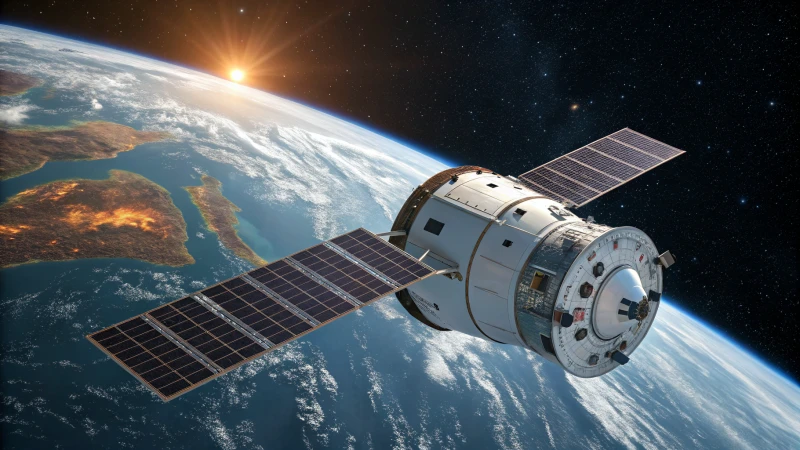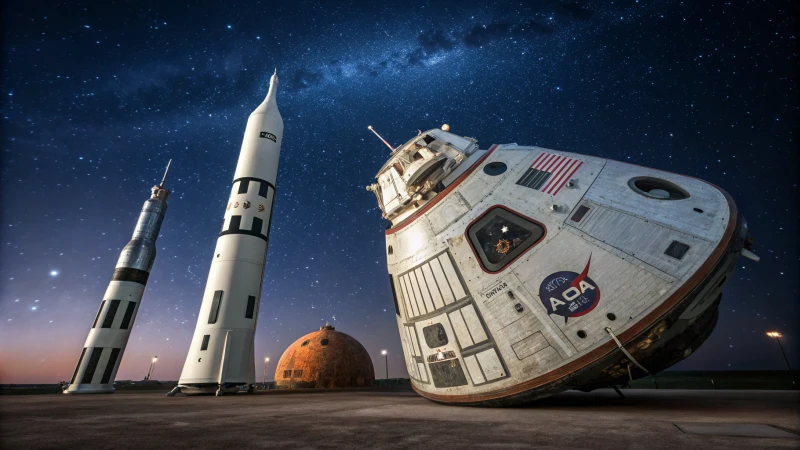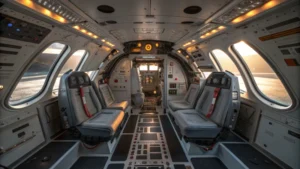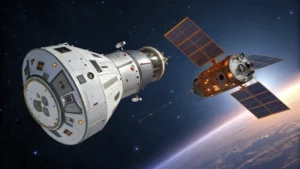
Ever wondered what it's like to travel in a space capsule? Imagine the thrill of zooming through the cosmos, but with safety and efficiency at its core.
A space capsule is a compact spacecraft designed to transport crew and cargo between Earth and space. Its main roles include emergency escape, scientific missions, and ferrying astronauts to space stations or other celestial destinations.
When I first learned about space capsules, I was amazed by their elegant simplicity and resilience. These little powerhouses are built for safety and reliability—qualities that make them indispensable for space missions. Beyond just being a vehicle, a space capsule can transform into a lifeboat, a laboratory, or even a temporary home for astronauts. With its aerodynamic shape and sturdy heat shield, it withstands the intense re-entry into Earth's atmosphere, a feat that always leaves me in awe of human engineering. Whether it's the historic Apollo missions or modern-day adventures with SpaceX's Crew Dragon, space capsules continue to push the boundaries of what's possible in space exploration.
Space capsules are primarily used for transporting astronauts.True
Space capsules are designed to carry astronauts to and from space safely.
Space capsules cannot serve as emergency escape vehicles.False
One of the primary functions of space capsules is as emergency escape vehicles.
What Are the Key Design Features of a Space Capsule?
Ever wondered what makes a space capsule ready for the ultimate journey beyond our blue planet? These tiny marvels are packed with design features that prioritize safety and efficiency.
Space capsules boast key design features like an aerodynamic shape for re-entry stability, advanced thermal protection systems to endure extreme temperatures, and a pressurized cabin ensuring crew safety and comfort.

Aerodynamic Shape and Stability
I remember the first time I saw a space capsule model—it was love at first sight with its sleek, conical shape. This design isn’t just for show; it’s crucial for stability during re-entry into Earth's atmosphere. The aerodynamic form minimizes aerodynamic drag1 and ensures the heat is spread evenly, which is vital when you're racing back to Earth.
Thermal Protection Systems
Imagine sitting in a metal box hurtling through space, facing temperatures hotter than your average pizza oven. That’s why these capsules are equipped with advanced thermal protection systems. Ablative heat shields are a true lifesaver, absorbing and dissipating heat to prevent the capsule—and its occupants—from becoming a cosmic barbecue.
Pressurized Cabin
The thought of floating in space without a breathable atmosphere is pretty terrifying, right? That’s where the pressurized cabin comes in. It’s like having a little piece of Earth with you. This cabin maintains Earth-like conditions, ensuring astronauts can breathe easy and stay comfortable on their stellar journey.
Compact Size and Modular Design
Space capsules are like the smart cars of the cosmos—compact but mighty. Usually built to house 2 to 7 astronauts, their small size makes them efficient for transport while still packing in all necessary life-supporting features.
| Feature | Description |
|---|---|
| Shape | Conical or rounded for stability |
| Thermal Protection | Ablative heat shields |
| Pressurized Cabin | Maintains Earth-like atmosphere |
| Size | Compact, 2-7 astronauts |
Components and Safety Mechanisms
Every capsule is a high-tech fortress with several key components:
- Crew Module: Where astronauts live and operate the spacecraft. It's like their mobile home in the universe.
- Service Module: This is the workhorse, providing propulsion, power, and storage.
- Launch Escape System: Think of it as an ejector seat for the whole capsule—a critical safety feature during launch emergencies.
These elements are meticulously designed to ensure that every mission is as safe as possible.
Applications in Modern Space Exploration
Space capsules are as versatile as they come. Whether it’s ferrying astronauts aboard NASA's Orion or SpaceX’s Crew Dragon, aiding in scientific exploration, or transporting cargo to space stations, these capsules are indispensable in modern space travel.
Emerging Innovations
The sky is no longer the limit as new innovations in space capsule design emerge. With private companies pushing boundaries, we're seeing the rise of reusable capsules aimed at reducing costs and making space travel more accessible for everyone. Who knows—maybe one day we'll all get a chance to experience space tourism2 firsthand!
Space capsules have a conical shape for re-entry stability.True
The conical shape minimizes drag and ensures stability during atmospheric re-entry.
Space capsules can house up to 10 astronauts comfortably.False
Space capsules are typically designed to hold 2–7 astronauts, not 10.
How Do Space Capsules Ensure Safety During Re-entry?
Ever wondered how astronauts survive the fiery return to Earth? It’s not just about strapping in and hoping for the best. Let me take you on a journey through the engineering genius behind space capsules that ensures their safety during re-entry.
Space capsules ensure safety during re-entry by utilizing aerodynamic shapes, sophisticated thermal protection systems, and parachute-assisted descents. Their conical design reduces drag, while heat shields withstand temperatures over 2,700°F, keeping astronauts safe inside.

Aerodynamic Design and Stability
Imagine a rollercoaster ride but on a cosmic scale. Space capsules adopt a conical or rounded shape, which is pivotal for stability and heat distribution3 during re-entry. This design minimizes aerodynamic drag, allowing the capsule to glide smoothly through Earth's atmosphere. This shape also helps in evenly distributing the intense heat generated, preventing localized hotspots that could damage the structure.
Thermal Protection Systems
Think of this: you're hurtling back to Earth, temperatures soaring beyond 2,700°F (1,500°C). Enter the thermal protection systems—these are like the unsung heroes of re-entry. Ablative heat shields work by absorbing and then slowly eroding the heat away. The materials used—reinforced carbon-carbon and ceramic tiles—have stood the test of time, having proven their worth in iconic missions like Apollo and Space Shuttle4.
| Material | Used In | Benefits |
|---|---|---|
| Ablative Heat Shields | Apollo Missions | Erosion absorbs heat |
| Reinforced Carbon-Carbon | Space Shuttle | High thermal resistance |
| Ceramic Tiles | Modern Capsules | Durable and reusable |
Parachute-Assisted Descent
Picture this: after surviving the atmospheric inferno, the capsule needs to slow down for a graceful landing. This is where parachutes come in—a staple since the Soyuz missions5. Whether it's SpaceX’s Crew Dragon or any other modern marvel, this system remains a trusty companion.
Deployment Sequence
- Drogue Parachutes: These kick in first to stabilize the capsule.
- Main Parachutes: They take over to ensure a gentle landing.
Life Support and Safety Features
Inside the capsule, it's all about creating a haven. A pressurized cabin provides breathable air, and life support systems work tirelessly to keep everything in check. They manage oxygen supply, carbon dioxide levels, and temperature control. In case of malfunctions, emergency protocols and backup systems ensure astronauts’ survival.
Safety Protocols
- Redundant system checks pre-re-entry
- Automated emergency procedures
- Communication links for real-time monitoring by ground control teams
Harnessing advanced technologies6 and robust engineering principles, these capsules are a testament to human ingenuity. As technology evolves, so do these systems, integrating new materials and innovations to enhance safety and reliability, ensuring that our space explorers return home safely every time.
Space capsules use ablative heat shields for re-entry.True
Ablative heat shields absorb and dissipate heat by eroding, protecting capsules.
Parachutes are not used in modern space capsule landings.False
Parachutes are crucial for decelerating capsules during descent, ensuring safe landings.
How Do Space Capsules Impact Modern Missions?
Remember that childhood dream of becoming an astronaut? It's fascinating how space capsules are the unsung heroes making those dreams closer to reality.
Space capsules are the cornerstone of modern space missions, ensuring the safe transport of astronauts and cargo, serving as emergency escape vehicles, and supporting crucial scientific research. Their design focuses on safety, efficiency, and functionality, making them indispensable in today's space exploration efforts.

Transporting Astronauts and Cargo
I remember the awe I felt watching astronauts launch into space. These journeys rely heavily on space capsules, which play a pivotal role in transporting astronauts and cargo to destinations like the International Space Station7. Imagine being in a small, pressurized cabin that ensures a safe environment while hurtling through space—it's a marvel of engineering!
With their compact and efficient designs, capsules are cost-effective workhorses for these missions.
| Feature | Description |
|---|---|
| Pressurized Cabin | Ensures safe, breathable atmosphere |
| Thermal Protection | Shields capsule from extreme re-entry heat |
| Crew Capacity | Typically houses 2-7 astronauts |
Emergency Escape Vehicles
Safety is everything. These capsules double as lifeboats. In the event of a launch malfunction, they're equipped with a launch escape system that can quickly detach from rockets to minimize risks.
This capability is critical for minimizing risk during launches.
Supporting Scientific Research
Capsules aren't just about transportation—they're floating laboratories. They facilitate experiments in microgravity and bring valuable data and samples back to Earth. Picture NASA's Orion capsule; it's a key player in our quest to explore the Moon.
For example, NASA's Orion capsule is instrumental in lunar exploration initiatives.
Historical Context and Modern Examples
Think about how far we've come since NASA’s Apollo Command Module. Today, innovations like SpaceX’s Crew Dragon and NASA’s Orion are at the forefront, paving the way for Mars colonization.
You can explore Crew Dragon’s latest mission8 to delve deeper into its capabilities.
Advantages and Design Challenges
Space capsules are celebrated for their simplicity and reliability. Their streamlined design reduces the chance of mechanical failures. Yet, they face challenges:
- Limited space means careful planning of resources.
- Extended missions might require additional modules.
Despite these hurdles, capsules remain the backbone of space exploration, striking a balance between cost-efficiency, safety, and functionality.
To grasp the engineering behind these marvels, check out the thermal protection technology9 used in these capsules.
Space capsules house up to 10 astronauts.False
Space capsules typically house 2-7 astronauts, not up to 10.
Capsules are critical for Mars colonization plans.True
Capsules are key to future ambitions like Mars colonization.
What Notable Space Capsules Have Shaped Our Journey to the Stars?
Imagine traveling back in time to witness the dawn of space exploration. These capsules didn't just transport astronauts; they carried our dreams of reaching the stars.
Key space capsules like NASA's Apollo Command Module, Russia's Soyuz, and SpaceX's Crew Dragon have played pivotal roles in space exploration. They enabled human spaceflight and scientific breakthroughs, marking significant milestones in space technology.

The Pioneers of Space Exploration
Growing up, I was fascinated by the stars and the idea of venturing into space. I remember watching documentaries about the Apollo missions and feeling a rush of excitement as if I were part of that historic journey myself. The Apollo Command Module, with its iconic conical shape10, was more than just a vessel; it was a symbol of human courage and innovation. This capsule was designed to withstand the blazing heat of re-entry, ensuring astronauts' safe return after their lunar adventures.
Evolution of Design and Functionality
As technology advanced, so did the design and functionality of space capsules. I find it fascinating how modern capsules like SpaceX's Crew Dragon have transformed space travel. Imagine a spacecraft that almost flies itself, allowing astronauts to focus more on the mission and less on manual controls. Crew Dragon's sleek, reusable design not only looks like something out of a science fiction movie but also significantly reduces costs—making the dream of commercial space travel more accessible than ever.
| Capsule Model | Launch Year | Key Missions |
|---|---|---|
| Apollo Command | 1966-1972 | Lunar landings |
| Soyuz | 1967-present | Continuous crewed spaceflights |
| Crew Dragon | 2020-present | ISS crew transportation and private missions |
Contributions from Global Players
On the global stage, the Russian Soyuz capsule stands out as a testament to resilience and reliability. Even today, it continues to ferry astronauts to the International Space Station (ISS). It's incredible to think about how this capsule has remained a cornerstone in international cooperation11 since the 1960s, bridging gaps between nations in pursuit of a common goal.
The Role of Private Sector Innovations
In recent years, private companies like SpaceX and Blue Origin have turned what was once the domain of governments into a thriving industry for innovation. I’ve always been intrigued by how Blue Origin's New Shepard is pioneering suborbital tourism. This shift towards commercial space travel12 is not just about democratizing access to space; it’s about unlocking new economic opportunities and inspiring a new generation to look up at the stars with wonder.
The Apollo Command Module was used for lunar landings.True
It facilitated humanity's first steps on the Moon from 1966 to 1972.
SpaceX's Crew Dragon is designed for single-use missions only.False
Crew Dragon's reusable design reduces mission costs significantly.
Conclusion
Space capsules are compact spacecraft designed for safe crew and cargo transport, featuring advanced thermal protection, aerodynamic shapes, and essential life support systems for modern space exploration.
-
Learn how a conical shape enhances stability during atmospheric re-entry, minimizing drag. ↩
-
Discover companies leading innovations in reusable capsules and commercial space tourism. ↩
-
Explore how aerodynamic designs reduce drag and heat during re-entry, ensuring capsule stability. ↩
-
Discover the materials and technologies that safeguard space capsules from intense re-entry heat. ↩
-
Learn about the successful parachute systems used in Soyuz missions, a model for current technologies. ↩
-
Uncover cutting-edge technologies improving safety measures in modern space capsules. ↩
-
This link provides insights into the operational dynamics of space capsules in delivering crew to the ISS. ↩
-
Discover details about Crew Dragon's recent mission, showcasing its role in modern space exploration. ↩
-
Explores the advanced materials safeguarding capsules during intense re-entry heat. ↩
-
Learn how the Apollo Command Module's conical design ensured safe re-entry from lunar missions. ↩
-
Explore the role of Soyuz in fostering international partnerships through ISS missions. ↩
-
Understand how Blue Origin's New Shepard is making commercial space travel a reality. ↩










